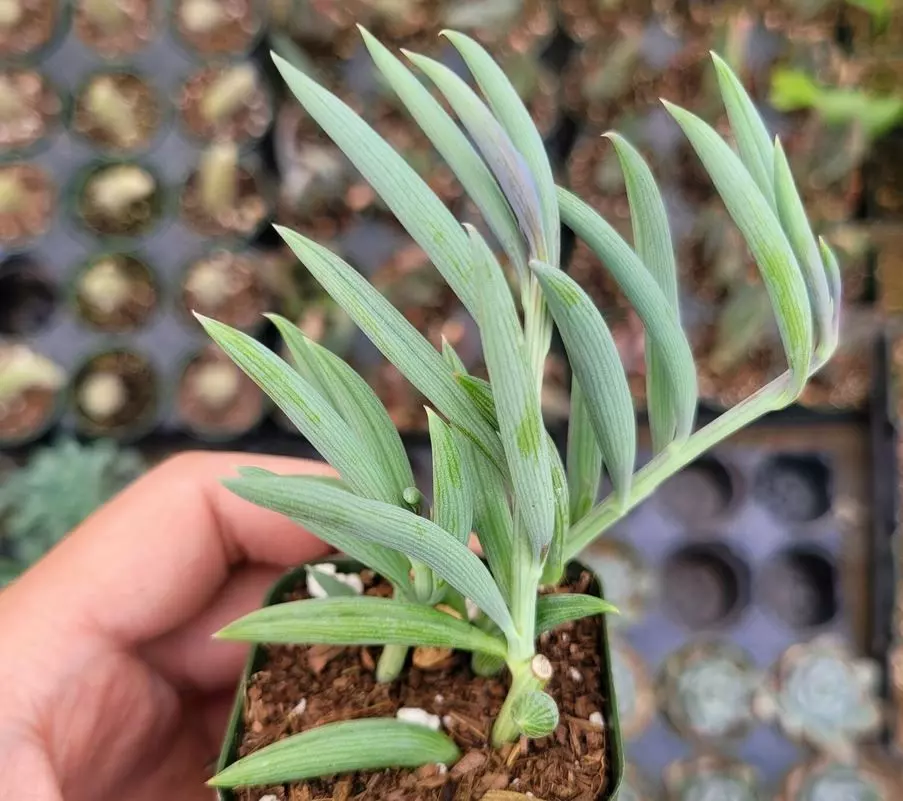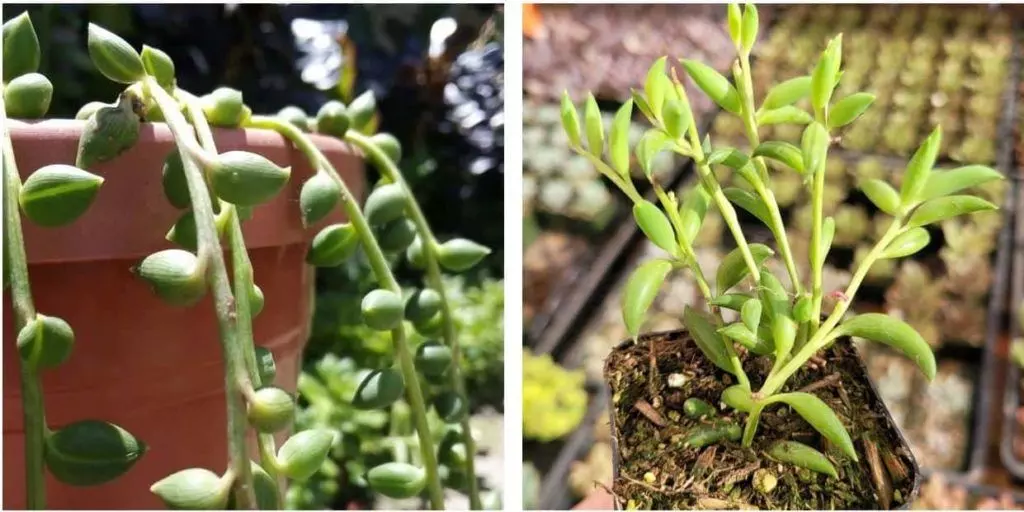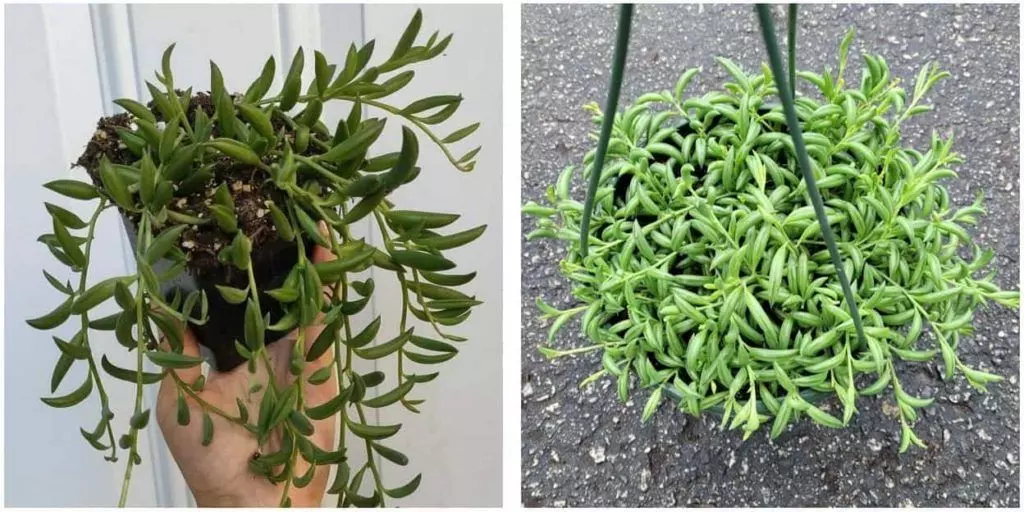Senecio radicans, also known as String of Bananas, is a succulent plant that can grow indoors as well as outdoors. The String of Banana plant receives the name because of its curved blue-green foliage and stems that develop in a rather peculiar way, similar to a banana-shape. Here you will find everything you need to know about how to care for the String of Bananas Plant, to identify problems, and How to Revive the String of Bananas Succulent Plant.
The String of Bananas (Senecio radicans) is a succulent plant related to the Senecio kleiniiformis, also known as Spear Head or Spear Head Senecio and related to String of Dolphins (Senecio peregrinus).
The String of Bananas is a perennial species of succulent plant with an exotic appearance. String of Bananas grows well outdoors but adapts very well indoors. Like most succulents, Senecio is a plant that is easy to grow and easy to maintain.
It is native to Namibia and South Africa, where it can be seen growing wild at the base of rocks, drought-tolerant plants are separated from each other by sandy or rocky soil. Their succulent tissues help conserve moisture, a characteristic that allows them to fully adapt to dry and hot conditions. Learn all about String of Bananas Care in this article.
Table of Contents
How to Care for String of Bananas
Light and Temperature String of Bananas
Indoors String of Bananas
When String of Bananas is growing indoors it is preferable to place it in a place where it receives excellent light. Although in the summertime should not be placed near the hot glass of a window or for a long time under the sun. In open spaces, preferably a place where it takes advantage of the morning sun and afternoon shade. This species enjoys robustness that allows it to withstand temperatures that can range from 24.8 °F to 109.4 °F (-4º C to 43º C).

Soil For String Of Bananas
Potting Mix For Banana Plant
The soil recommended for the String of Bananas plant is a light mix for succulent and cactus plants. Soil components should give the ability to quickly drain water, such as soil rich in sand, vermiculite, or perlite. When potting, you can add a cactus mix, to better root your succulent plant. In this way, you can prevent its roots from rotting. As with most succulents, keep your specimen in a dry, rather than humid place if possible. It is a fast-growing species.
How Often Do You Water String Of Banana?
How Often Should I Water the String of Bananas?
When the String of Bananas is located indoors, it is recommended that you water it every two weeks, and give only a little water, except for the winter season during the rains. Now, if the plant is in an interior space in your home, you can water it every 3 to 6 weeks, depending on the season. It is important to make sure that the soil is completely dry between waterings. If the plant has good drainage, then the frequency of watering is not as important.
The best way to water a String of Bananas properly is to check the soil moisture. Using your hands check how moist is the soil at a depth of 1 or 2 inches. If you are feeling the moisture in your fingertips, do not water the plant.

Why Is My String Of Bananas Shriveling?
If the leaves of your String of Bananas Plant are starting to wilt or look shriveled, likely, your succulent plant is not getting enough water. Water should enter through the roots, therefore, avoid contact of the leaves with the water. That will prevent the leaves from rotting.
Fertilization
Senecio does not require any fertilizer, but if you prefer, you can choose an organic liquid fertilizer prescribed for houseplants and apply it during the spring. Under no circumstances fertilize in winter.
Senecio radicans is a drooping plant that forms a cascade of slender, ductile stems covered with curved, blue-green leaves. It resembles Senecio rowleyanus, but its leaves are larger, elongated, lanceolate, and spherical but subtly curved upward, their translucency allowing sunlight to shine through them, scattered, alternate, they show a delicate branching pattern of strands. If grown on the rocks, it will root along the entire length of its stems.
Thick-stemmed, glabrous, somewhat erect, its branches are slender and wavy, 1 meter or more in length, often wing-shaped, rooting. The evenly spaced leaves form a sort of chain of green bananas as they spread along the ground.
String Of Bananas Bloom
The String of Bananas blooms every year, with white and mauve flowers emerge during autumn and winter, possessing a sweet cinnamon scent.
Toxic for Cats, Humans, Dogs
Senecio radicans are not suitable for consumption, because are toxic.
Decoration with String of Bananas
Senecio radicans looks best in hanging baskets and wall pots. It is also excellent for mixed container planting. It is a perfect plant for the garden, although because of its particular appearance, it looks good in almost any space you decide. You can place it indoors, as long as it receives enough light and has good ventilation.
The String of Bananas hanging succulent’s bluish-green, unparalleled leaves, and long, spreading stems add a complementary eye-catcher to any space in your home.
String of Bananas Pests and diseases
It is not common for this species to be attacked by pests, although it may have sandy insects such as the white mealybug, in which case you should wash the plant. That will prevent the roots from rotting.
String of Bananas Drying Up
If the leaves of your String of Bananas are starting to wilting or shriveling, your String of Bananas Plant is not getting enough water. The plant needs and likes deep brief watering. Before watering again, verify the soil dries out.
Learn more about How to Propagate String of Bananas Step by Step.
Where to Buy String of Bananas Plant?
If you can’t find your String of Bananas at your nearest nursery or store, we recommend these String of Bananas sellers.




